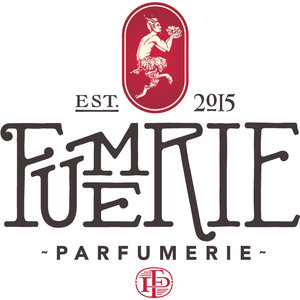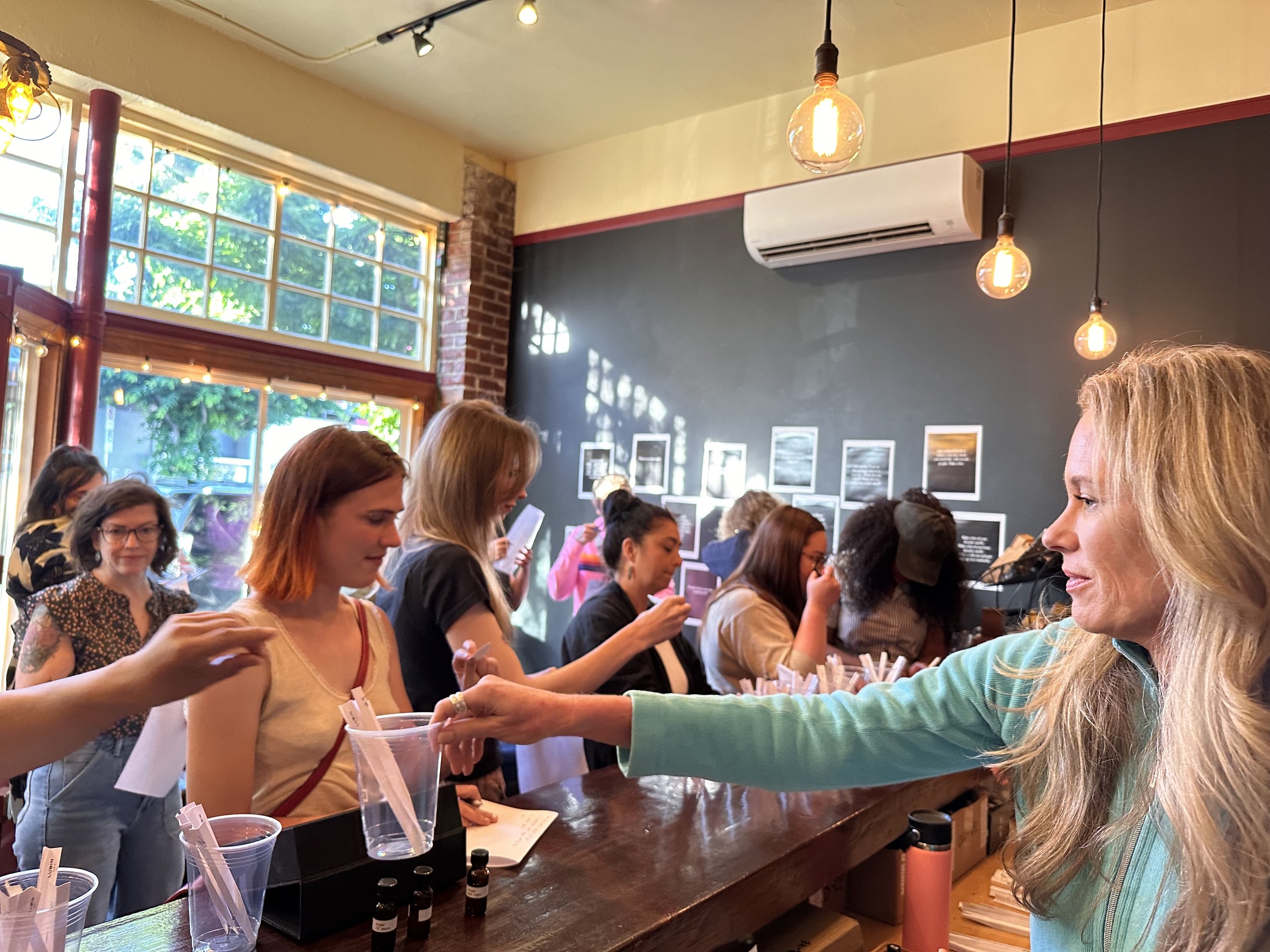On June 15 we were lucky enough to again host Catherine Haley Epstein for an event here at Fumerie. As a participant in Fumerie events on both sides of the bar, I found the event to be particularly engaging. The format of Catherine’s presentation welcomed a lot of audience participation, exploration, and creativity. We blind-smelled many perfume ingredients and wrote down our impressions of them, discussed some of Catherine’s inventive fragrances, and each listed ten smells we would show an alien visiting from another planet in order to help introduce them to Earth. Overall we were encouraged by Catherine to get outside of our normal comfort zone of smell description and experience, as she also does so well in her book Nose Dive.
Catherine’s visit stuck with me, and some specific conversations that came about organically during the event caused me to ruminate on a few specific concepts in the world of fragrant art; gender, notes, and artistic intention.
On Gender
As a cisgender white American male, I don’t make it a habit to proselytize my opinions on gender’s role in perfume because I do not believe the conversation or narrative needs to be shaped by me or those who fall in my demographic. I know a lot of people have strong opinions on the matter, and many of them have experienced gender-based adversity that I will likely never know. Out of respect for the experiences I cannot know, I ask that you take my opinions on this matter with a grain of salt.
I do consider myself someone who tries to be an ally and has railed against gender stereotypes as long as I have known of their existence. I came to fragrance largely because I found the gendered versions of fragrance to be reductive, pandering, boring, and (to me) offensively commodified. My main beef is with the binary, but I also am against gendering perfume- but not because I don’t think gender identity has a place in fragrance, I just can’t say I support the source material.
As a society, we have a lot of work to do in terms of understanding the spectrum of gender, and this is especially true in terms of language (and even more so in terms of universally accepted language). Being that our modern world has been so defined in terms of gendered products, I can’t see us developing a referential language for perfume that accommodates the true breadth of gender- but again my core issue is with the source material.
So what do I mean by source material? I mean referential language. I don’t agree with the idea that perfume should be explored and expressed solely through means of referencing the way other objects smell, and since this is the primary way that perfume is talked about, I especially do not think any commonly used referential material is inherently gendered. I am not alone in this opinion, but I do think songs, architecture, food, and other art forms are not inherently gendered by society and therefore perfume should not be either (Fabrice from Scents of Wood said so much just last week on the Scents of Wood Instagram account). This opinion is admittedly oversimplified because gender does come into play in art constantly, so I could see how gender does have a role to play in analyzing fragrant art but not categorizing it. Most exhibition or sale of art is not separated by gender, and it is especially not separated by which gender is more likely to (or even ‘should’) enjoy it.
While there may be elements of perfumery and fragrant art that contain commentary on gender, reference gender, or even push gender boundaries based on the commonly held conventions around gendered fragrances the source material for these fragrant explorations is still mainly based on the binary conventions long held by people with limited perspectives (mostly men) or the main intent of successfully marketing and selling fragrance above understanding the vast variety of experiences in a lived gender experience. Until we have a lot more time with a much more diverse group of people producing fragrance (that is also accessible to more people on the consumer side), I believe we are using referential language that is poorly allocated in terms of gendered experiences to the point it should be largely, if not entirely, ignored. In other words- I think it’s time we all let go of these conventions and start building new ones based on our own experiences! What puts me in touch with my masculinity may be (and likely is) different from the next person. Choosing a fragrance to wear based on how it makes you feel about yourself in relation to your gender is an amazing and empowering choice, and is also a choice that you should be free to make without the industrial-grade pressure of marketing conventions. Everyone should be free to find their own definitions, connections, and reference points (and in fact, we are)!
On Smelling Notes
Getting right back to discussing the ‘source material’ of referential language in describing scent- it is true that something helpful can also be limiting. I can think of many activities and skills where this is true, and many where guidelines and protocols are completely essential. I do not think anything having to do with art or its interpretation lands in the latter category (unless, arguably, you are a professional critic or creator). Fragrance stands alone as the only art form that most people think requires the tools of reference to interpret, and I believe this hinders a great many people in terms of experiencing the artistic side of fragrant compositions.
Often when I help folks with their consultations here in the shop, I will encourage them to explore the scent without knowing the supplied smelling notes before revealing the intended notes or backstory/ inspiration. One of the big reasons I choose to do this is because of Catherine’s book, and another perspective that reaffirmed my positions on ‘smelling outside the box’ was that of Sissel Tolaas’ views expressed in an episode of the podcast Perfume on the Radio. Overall, these experts reflected a sensibility and notion I had been internally mulling over for some time- do we need to acknowledge referential terminology to enjoy and explore fragrant art? Does referential language inhibit our ability to enjoy fragrance on a more emotional or intuitive level? Are there better ways to talk about fragrance as an art form than using the framework of reference?
Obviously smelling notes have a place in perfumery, but I do think the way we use them is largely strange and inhibiting. We don’t search for songs we like based on notes, paintings we like based on individual colors, or books we like based on how many times they use our favorite words. Fragrance, and smell in general, offer a type of comfort that these art forms do not- one that is harder to explain in its effect, and more intensely tied to deep personal memory (often on a level we cannot pinpoint). I believe this is one reason why referential language is the default for experiencing/ evaluating fragrance, but I also believe it is again a byproduct of streamlining sales. I don’t know exactly what I would propose “instead” of smelling notes, but I do know that allowing myself to experience fragrance without searching first for ingredient-referential words has enhanced my experience with the medium a great deal, and further reaffirmed for me that fragrance is my favorite artistic medium. I also know that the Odorbet project that Catherine co-founded is doing great work in expanding and exploring the world of descriptive language as it refers to scent in an accessible and open-source fashion, and deserves your time and attention.
Check out Odorbet here
Explore Nose Dive here
Find your new Carnet candle here


